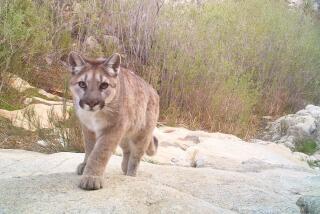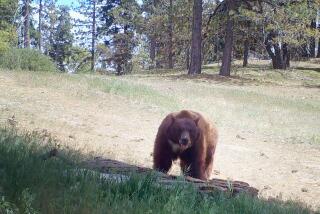Can we get along?
All the man jet-skiing along Quebec’s Gatineau River wanted was a big and unusual wild animal as a pet. But to claim the cute bear cub he saw paddling in the current last month, he figured he’d have to tame it a bit. So he ran it over. Then he roared around and rammed it again. And again.
As the mother bear watched from shore, the man swooped in and grabbed the weakened cub by a leg and, to further wear it out, dunked the creature underwater. And dunked it again. Then he tied it with a rope as he raced for the public dock, where Canadian wildlife officials intervened.
They didn’t charge the man in what they’re calling the “Buddy Bear” case. Nor, however, did they let him keep the cub, which is recovering in a wildlife sanctuary — yet another victim in a type of story that lately seems commonplace: A human and animal come together in a tale that is supposed to glow with warmth but instead takes a bizarre or chilling twist.
Increasingly, wildlife experts and veteran outdoor types are shaking their heads at what might be labeled the Doolittle Delusion — the belief that with the right attitude, it’s possible for a human to bond with a wild animal in the manner of Hugh Lofting’s fictional doctor, whose knack for sensitive rapport led to spirited, interspecies rap sessions.
Recent news clips reveal that socializing with lions and tigers and bears often turns unpleasant. Within the space of a few days this month, a 600-pound tiger dragged illusionist Roy Horn off a Las Vegas stage by the neck, and grizzlies in Alaska’s Katmai National Park killed photographer Timothy Treadwell and his girlfriend, Amie Huguenard, as they attempted to live among them. And then there was the tale of Antoine Yates, a New York cabby hospitalized after a run-in with a 400-pound Siberian-Bengal tiger.
The creature, which Yates had apparently taken in as a cub, had grown so big that it had taken over an apartment in a Harlem housing project. To capture “Ming,” a SWAT team rappelled down the side of the building and shot the big cat with a tranquilizer dart. Inside, authorities also found a 5-foot-long alligator.
Yates, whose injuries were relatively minor, told reporters he was keeping the creatures because he wanted “to show the whole world that we all can get along.” The tiger, he told the New York Times, “was like my brother, my best friend.”
Naturalist David Quammen, whose most recent book is “Monster of God: The Man-Eating Predator in the Jungles of History and the Mind,” puzzles at the paradox of people’s “ancient compulsion to bask in the magnificence” of the creatures they most fear. “Some people treat these things as accessories to their identity. And that’s true of animals generally, not just dangerous ones People say, ‘I’ve got a great big scarlet macaw in my living room. I must really love the wild.’ Well, wrong.”
Yet such interspecies infatuations have fueled a wildlife black market that’s only getting bigger — and the more dangerous the animal the better. The Humane Society of the United States estimates there are more captive big cats living in this country — as many as 10,000 — than all of those living in the wild in Asia. People have as many as 300,000 wolves or wolf-dog mixes roaming their homes or yards. And in 2000, people owned 9 million reptiles, including snakes, as pets. As many as 90% of these lizards and serpents die each year. But fatality cuts both ways in such relationships.
In 1999, authorities entered a Van Nuys trailer home and found a menagerie of poisonous snakes, piranhas and other exotic animals. In the middle of the living room lay Anita Finch, curled in a fetal position. Her hand, pierced by two small wounds, clutched a note: “Northridge Hospital ask for ICU.” The bite marks suggested she had been killed by one of her snakes, probably a rare, foot-long Gaboon viper.
“The lesson,” says Richard Farinato, who monitors captive wild animals for the Humane Society, “is don’t try to turn wild animals into stuffed toys.”
Common sense is not always the human species’ strong suit, though, and men and women often behave in ways that fall somewhere between risky and stupid, Farinato says, offering as evidence the photos he’s seen of people grinning beatifically while standing within charging distance of bison, elk and bears.
Michael Hutchins, director of conservation and science for the American Zoo and Aquarium Assn., is not amused by such naiveté.
“We have, as a people, become ignorant of animals and animal behavior,” he says. “Yet at the same time, we yearn to be close to animals and wildlife. It’s an odd combination, and it has some dire consequences.”
Jim Peddie, who runs Moorpark College’s respected exotic animal training and management program, says that once every two or three years the school has to drop a student. The reason: They can’t keep their hands off big animals. “Physical contact with the animal — that seems to be the thing that they crave,” Peddie says. People who love animals too much “make all kinds of assumptions that they can communicate with these animals, or that they are beyond the dangers. You never are beyond the dangers.”
In some cases, getting within chomping distance of a bear or mountain gorilla is part of the attraction, psychologists say. Consciously or not, people are making a raw power grab — hoping that if they survive their close encounter, the animal’s strength will transfer to them.
“The belief is that there’s danger, but I’ll be able to escape it,” says Steve Sultanoff, a psychologist and diver in Irvine. “It’s almost a sense of immortality: ‘I can get out of danger, I’m all-powerful.’ ”
The adrenaline and endorphins surging through the body only encourage that feeling, and incite an sense of transcendence. For someone who feels powerless, that’s a big draw, a way to compensate. “It creates a feeling of superiority,” says Sultanoff. “It says, ‘I’m different from others. I can do things others can’t do.’ ”
For many, the phenomenon becomes even more intoxicating in the wild. “Americans love their pets, but wild animals are magical,” says Deb Liggett, the outgoing superintendent of Katmai National Park, where the bear maulings occurred. “Wild animals in their natural habitat are even more compelling and spectacular.”
Jim Oltersdorf, an Alaskan photographer, shares that view. But he has no use for the notion of interspecies friendship. He considered the late Treadwell “an idiot.”
As it happens, about the time Treadwell was mauled, Oltersdorf was hunting grizzlies in the park. Treadwell made a point of eschewing even pepper spray. Smith was packing a huge Smith & Wesson .50-caliber handgun and another member of his party carried a powerful “buffalo gun.”
Even at close range, it took 12 shots to kill one large grizzly — ample evidence of the bear’s destructive ability, Smith says.
Oltersdorf has no sympathy for “fools” who venture into the backcountry without adequate defense, but thinks he knows why they do it: “The American public has bought into talking animals.”
Tom Smith, an Anchorage-based wildlife research ecologist with the U.S. Geological Survey, recently made a study of bear-human attacks in Alaska over the last century. By his reckoning, the maulings of Treadwell and Huguenard this month were 49th and 50th grizzly (brown) deaths in the last 100 years. Over the same time, black bears have been blamed for six deaths, and a polar bear was blamed for one. One reason, he says, is that bears are “on the A-list for charismatic megafauna.”
Smith, too, finds bears fascinating. However, when he finishes a day’s field work on the creatures, he takes his data back to camp and sits down to read a book, he says. “But people like Timothy [Treadwell] put their head in their hands and stare until the sun goes down. They just love bears.”
Taken too far, such appreciation can pervert people’s perspective on where they fit into the balance of nature, critics say — adding that some of the nutty notions for which city folk are famous get dangerous in the wild.
For instance, Smith recalls a scene described to him by a pair of wildlife photographers. They said they had seen a man in the Katmai National Park who was luring grizzlies close, only to whack them with a stick.
“I’m teaching them that humans are bad,” the man told the photographers.
Says Smith: “I can’t believe I breathe the same air as these people.”
Yet, it would seem that from an animal’s perspective — and many humans’ — too little sympathy can be even worse than too much. Bears make the point well, says Charlie Russell, a friend and persistent defender of Treadwell. Russell spent seven years studying bears in Russia and has the up-close pictures to prove it. Not long ago, he returned to the site of his research. Poachers had slaughtered all his subjects.
Like most of the bears he’s encountered, he says, these “were intelligent and peace-loving.” People portray them as otherwise for a reason, he says. “The hunters’ agenda is to make them out as dangerous so that they can feel better about killing them.”
The healthiest attitude, naturally, is likely somewhere between the extremes. Hutchins, of the Zoo and Aquarium Assn., lays some blame for recent casualties on “the more extreme conservation groups and animal-rights groups, which try to use fuzzy attitudes about animals — the fact that they’re warm and cuddly — as a way to engender empathy and caring.” That approach, he says, can backfire tragically. “We don’t just need concern about animals, we need informed concern,” he says. “”True conservationists have to be much more practical in their view of animals and animal relationships.”
Bruce Weide and his wife, Pat Tucker, were recently named educators of the year by the National Wildlife Federation. They have raised a wolf they acquired during the making of a documentary, but they take it to classrooms, Weide says, only to teach that wolves should be left in the wild.
Weide says he uses the story of Noah’s ark to make the point: “In the end, God says, ‘Get them off the ark.’ ” But today, Weide says, there’s not enough habitat left for all God’s creatures.
“In this increasingly overpopulated world, wolves need to be left alone and to have a place to be left alone in,” he says. “They don’t need us to love them or provide for them.”







